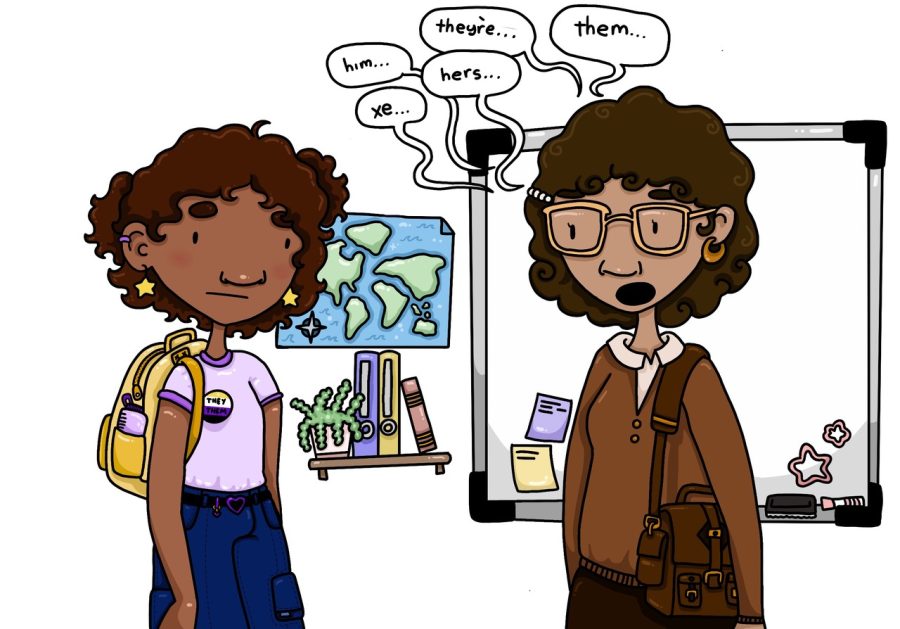Pronoun problems: Students frustrated when teachers don’t use the right pronouns
While many teachers at Lab acknowledge students’ preferred pronouns, transgender and genderqueer students expressed frustration with those that don’t.
February 1, 2022
Ladies and gentlemen. Boys vs. girls. His or hers. Sitting at a desk in a school that emphasizes inclusion, transgender students say teachers regularly use terms that do not acknowledge their gender identity. Without an easy way to report teachers, and fearing their grades being affected, these students have few other options except to bottle their frustrations.
With the 2021 health and wellness survey reporting that 12% of the U-High student body identifies as “other gender or unspecified,” teachers have had to become more accustomed to using non-cisgender pronouns. Despite the growing population of transgender students, many say teachers still often assume their gender identities, which has caused frustration.
In some classes, gender is more prominent in the curriculum, where many transgender students expressed feeling excluded. Many of the world languages taught at U-High are gendered, forcing nonbinary students to choose between female and male pronouns.
Senior Kai McManus, who uses gender-neutral pronouns, decided to use masculine pronouns in Spanish class, without the option of using nonbinary pronouns.
Balancing a respect for student identities with a respect for Romance languages, middle school Spanish teacher Deb Foote, who co-advises the LGBTQ+ alliance, Spectrum, says the lack of gender-neutral pronouns in Spanish class is due to the responsibility teachers have to teach the language as it is written and spoken in Spanish-speaking countries.
“When we’re talking about the identity of students as individuals, there is an awareness about it, and of course we want to respect that as a department and as teachers,” Ms. Foote said, “but we are limited in the ways we can do it.”
Despite noticing an increased awareness of pronoun use in the past few years, sophomore Willow Stern, who uses gender-neutral pronouns, says teachers still assume their gender roughly three times a day. Worrying about being treated differently, Willow decided to not reveal their preferred pronouns to some teachers, causing teachers to use pronouns based on the teacher’s perception of Willow’s gender identity.
When misgendered, student reactions vary from having conversations with teachers after class to staying silent. These reactions often depend on how comfortable a student feels with their teacher.
“Most of my teachers, I feel comfortable telling them,” Willow said. “So I would respond if they use she/her pronouns for me. I typically just butt in and say, ‘Hey I use they/them pronouns’ before they could finish what they were saying.”
Transgender students have expressed appreciation toward teachers who are proactive in using the correct pronouns, but many have only noticed a handful of such teachers.
“I only have a couple of teachers who are open to that kind of discussion,” said ninth grader Ace Ma, who uses gender-neutral pronouns. “I think that a lot of them say that they’re comfortable with it, but there’s no actual effort in trying to change their ways.”
While teachers often mistakenly misgender students, it is usually the lack of acknowledgment of the mistake that transgender students say they find upsetting.
“I have some teachers who are more apologetic than others. I have some who just kind of nod and I have some who just keep steamrolling ahead,” Willow said. “Most of the time when I address it pretty directly they’re OK with it.”
Science teacher Zachary Hund has attempted to be more respectful by providing a Google form where students can fill out their preferred names and pronouns at the beginning of the year.
According to Dr. Hund, the expansion of the diversity, equity and inclusion curriculum to include pronoun usage has helped Lab teachers to be more mindful of transgender students.
“I know a lot of faculty feel like how I feel, which is, we’re nervous,” Dr. Hund said. “We want to respect their decision, but this is new to us, and we want to do what we can to make students feel welcome.”
A number of students who have not yet revealed their gender identity to their parents asked teachers to use different names and pronouns in progress reports and emails, which many teachers have not done. After a teacher did not make this change for Ace, they said they were frustrated because they lost the opportunity to choose when to come out to their parents.
As transgender and genderqueer students continue to face discrimination at Lab, Kai said they would like to see a more accessible way to report teachers.
Willow said U-High students and teachers need to be more mindful of transgender students in order to make them feel more welcome at Lab.
“The main thing people could do would be to start being more proactive, because I feel like there’s a lot of pressure on the community to point out when people make mistakes,” Willow said, “and even though I know everyone is trying their hardest, I would really appreciate it if they could try to solve those problems before it comes to us.”





























































